India's Drone Industry: India's New Engine for Economic Transformation?
Discover how India’s drone industry is emerging as a new engine for economic transformation by 2030. Explore rapid market growth, government PLI incentives, cutting-edge drone startups, defense innovations, and India’s vision to become a global drone manufacturing and export hub. Learn about key sectors like agriculture, logistics, and defense driving this tech revolution.
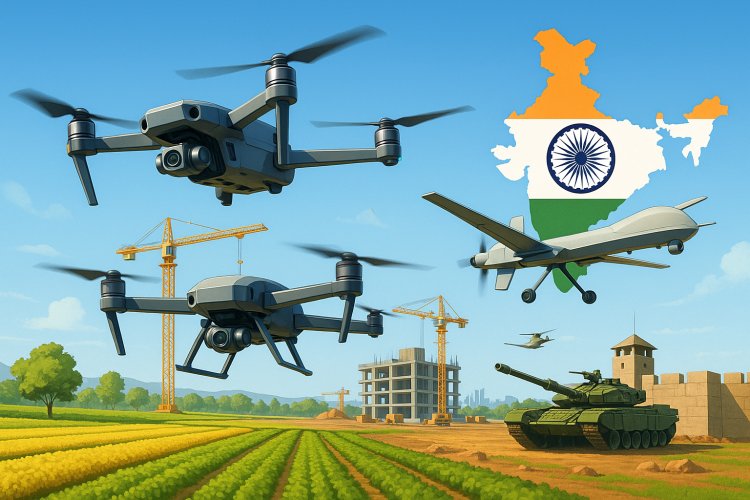
India's Drone Industry: The Next Big Thing? Propellers & Profits: India’s Growing Drone Industry
I still remember the first time I watched a drone hover silently above me at a wedding, its rotors whispering something I didn't understand then. But now, it's clear – "Opportunity of Investment"! These technological marvels have transcended mere YouTube vlogs and marriage shoots, reshaping warfare, farming, construction, and even the flow of capital on Dalal Street. India, with its vast geographical expanse and diverse needs, is rapidly embracing this aerial revolution, driven by an ambitious vision to become a global drone hub. As Defence Minister Rajnath Singh articulated at the Delhi Defence Dialogue, "India is aiming to become a drone hub of the world." This isn't just a technological trend; it's a national strategy with profound economic and strategic implications.
The Drone Market at Takeoff: Soaring Growth Projections
The global drone market, a formidable USD 73 billion in 2024, is projected to surge to USD 84 billion by the end of 2025, exhibiting a robust 14% annual growth through 2030. While North America currently leads this market, the Asia-Pacific region, spearheaded by China and India, is emerging as the fastest-growing segment.
India is not merely a passive observer but an active participant, adapting rapidly to this global shift. Civil Aviation Ministry projections, supported by KPMG, estimate the Indian drone industry to reach a staggering ₹120–150 billion (approximately USD 1.5–1.9 billion) by 2026. This rapid expansion is underscored by the explosive growth in domestic drone manufacturing, with annual sales turnover expected to skyrocket from ₹60 crore in 2021 to ₹900 crore by 2025.
-
Current Valuation & Growth:
-
The Indian drone market is projected to grow from $654 million in 2024 to $1.43 billion by 2029, maintaining a compound annual growth rate (CAGR) of 17%.
-
Domestic drone manufacturing is expected to achieve annual sales turnover of ₹900 crore ($108 million) by 2025, a colossal jump from ₹60 crore in 2021.
-
-
Global Arena:
-
Future Outlook:
-
India’s drone industry could unlock up to $23 billion in manufacturing potential by 2030, with defense and agriculture leading the demand surge.
-
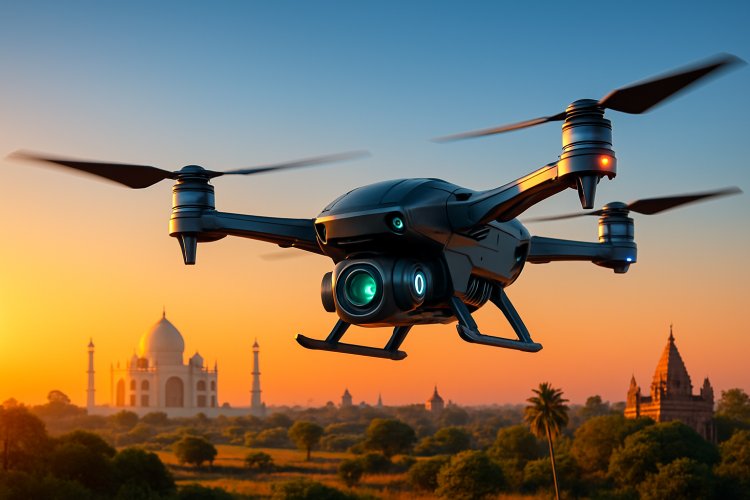
Drone Sector Driving Forces: Policy, Reforms & Incentives
-
PLI (Production Linked Incentive) Schemes:
Production-Linked Incentive (PLI) Schemes: The initial PLI scheme in 2021 injected ₹120 crore into the sector. Now, whispers of a more substantial ₹1,000 crore PLI 2.0 are circulating, aimed at boosting local component manufacturing and reducing import dependency. This incentivizes domestic players to enhance their manufacturing footprint and integrate deeper into the global value chain.
-
Government initiatives like the PLI scheme have been pivotal, allocating ₹120 crore over three years (20% value addition incentive) to domestic drone manufacturers.
-
Proposals to expand the scheme up to ₹1,000 crore are under discussion to encourage local component production and reduce dependency on imports.
-
-
Regulatory Spring:
Drone Rules 2021: A Regulatory Tailwind: The landmark Drone Rules 2021 have significantly streamlined the regulatory landscape.By largely eliminating individual licenses, establishing a user-friendly UDAN-drone portal, and designating five dedicated UAV corridors, these rules have dramatically increased drone registrations from 346 in July 2022 to over 5,000 by July 2023, fostering a more conducive environment for drone operations. -
The 2021 Drone Rules streamlined licensing, introduced the one-stop UDAN drone portal, and created five UAV corridors.
-
-
Import restrictions on foreign drones, especially from China, have fueled local innovation and startups.
Registered drones surged from 346 (July 2022) to over 5,000 (July 2023).
Make in India:
"Make in India" and Defence Procurement: The "Atmanirbhar Bharat" (Self-Reliant India) initiative has a strong emphasis on indigenous drone development.The urgent lessons from conflicts like the Russia-Ukraine war, where drones played a pivotal role in surveillance, targeting, and even kamikaze attacks, have solidified India's resolve. This is evident in fast-tracked defense procurements, such as the order for 450 indigenous Nagastra-1R "suicide drones" in May 2025 (following 480 in 2024), showcasing a clear commitment to self-reliance in critical defense technologies.
Companies like Raphe mPhibr recently secured a staggering US $100 million Series B funding, the largest drone raise in India's history, bringing its total funding to $145 million for developing mission-critical UAVs for the armed forces. Furthermore, states like Tamil Nadu are rapidly emerging as key drone manufacturing clusters, hosting innovators like Dhaksha, Garuda Aerospace, Zuppa Geo Navigation, and Big Bang Boom. These clusters benefit from state defense corridors and dedicated UAV test centers, fostering a collaborative environment for innovation and production. -
Applications: Where Drone Propellers Drive Profits
| Sector | Application Examples | Impact |
|---|---|---|
| Agriculture | Crop spraying, mapping, health checks | Boosts yields, cuts input costs, enables precision farming |
| Defense & Security | Surveillance, loitering munitions, border patrol | Enhances national security, indigenous "suicide drones" like Nagastra-1R |
| Logistics | Package delivery, inventory management | Revolutionizes e-commerce, logistics, rural access |
| Construction & Infra | Mapping, site surveys, project monitoring | Accelerates smart city planning, efficient project management |
| Healthcare | Medical supply delivery, disaster relief | Improves reach in remote locations |
| Media/Events | Cinematography, live broadcasts | Transforms storytelling and coverage |
The Drone Startup Magnet: Funding and Innovation
-
Ecosystem at a Glance:
-
Over 200 drone startups have emerged, collectively raising more than $140 million since 2014.
-
Big winners: Raphe mPhibr raised $100 million Series B, the largest for an Indian drone company.
-
Tamil Nadu is emerging as a drone cluster hub, nurturing innovation through a dedicated state defence corridor.
-
Homegrown Drone Heavyweights & Stock Market Darlings
Notable Indian Startups Enabling Innovation
-
ideaForge: Rugged, autonomous ISR (Intelligence, Surveillance, Reconnaissance) drones for the military, with patented technologies for GNSS-denied operations.
-
Aereo: AI-based commercial drones and cloud data platforms for agriculture, infrastructure, and mining.
-
Vecros: Own PCB and vision-based navigation for non-GPS environments.
-
Flying Wedge Defence & Aerospace: Nearly all-indigenous hardware for defense/agriculture with minimal import reliance.
-
Vyomastra: AI-powered drone and anti-drone technologies for security and commercial uses
What’s Powering This Drone Boom?
India’s drone sector is at the forefront of integrating AI, advanced sensors, swarm technology, and indigenous hardware, underpinned by bold government initiatives and a vibrant startup ecosystem. These innovations are not only fueling market growth but also enhancing the competitiveness and “Make in India” thrust of the industry, positioning India to become a global leader in drone technology for the next decade and beyond.
-
Government Incentives:
-
PLI and exclusive regulatory attention.
-
-
Tech Leap:
-
Critical National Need:
-
Startup Innovation:
-
Niche-specialized platforms, advanced sensors, and payload systems for Indian market needs.
-
Challenges and Risks In Drone Sector
-
Component Dependency:
-
Regulatory Gaps:
-
Global Competition:
-
Capital Intensity:
The Future Drone Flight Path: Vision 2030 and Beyond
India’s pursuit of becoming a global drone powerhouse is more than aspirational; it is an imminent economic transformation, promising widespread prosperity, innovation, and global recognition as a leader in smart industries.
-
By 2030, India will likely be a top-tier global drone hub, exporting both drones and drone-related technology to international markets.
-
The country’s multi-pronged strategy—leveraging IT strengths, regulatory agility, and a vibrant startup ecosystem—will secure its position in the next wave of global industrial leaders
-
Transformation Engine:
-
Policy Push:
-
Investor Outlook:
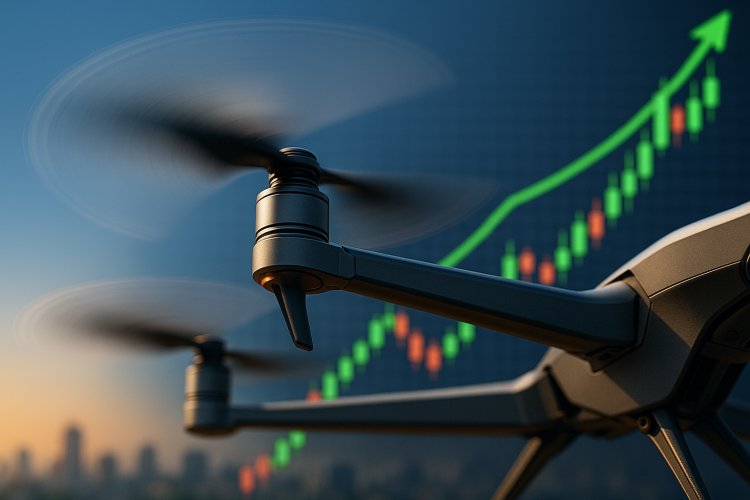
How India's Goal to Become a Global Drone Hub Will Transform Its Economy in the Next Decade
Massive Economic Opportunity
India's ambition to become a global drone hub has the potential to transform its economy by 2030, unlocking an estimated $23 billion in manufacturing potential. This surge is expected to boost GDP by 1–1.5% and position India as a key player in advanced manufacturing, technology services, and exports.
Sectoral Impact
1. Manufacturing & Exports
-
Domestic manufacturing is set for dramatic expansion, bolstered by the government’s Production-Linked Incentive (PLI) scheme and import restrictions on foreign drones.
-
India is projected to secure up to 10% of the global drone market by 2030, with substantial gains in component manufacturing, hardware assembly, and R&D.
-
As Indian manufacturers mature, the country is expected to emerge as a credible alternative to Chinese suppliers in global drone markets.
2. Agriculture
-
Agricultural drone use will lead to 10x faster monitoring and up to 75% cost reductions in spraying operations, transforming food production and resource management.
-
By 2030, agriculture is anticipated to be the largest domestic user, expanding precision farming and boosting rural incomes.
3. Infrastructure & Construction
-
Drones will enable 80% faster progress monitoring and as much as 40% savings in land and site survey costs.
-
Widespread drone deployment will lead to smarter urban development and rapid rollout of critical infrastructure projects.
4. Logistics & E-Commerce
-
Drones will revolutionize last-mile delivery, especially in rural and remote areas, improving supply chain efficiency and creating new business models in e-commerce and express logistics.
5. Defense & Security
-
Adoption of indigenous defense drones strengthens national security, supports exports, and develops high-tech talent ecosystems.
-
India's large-scale deployment of drones in military and disaster management use-cases is seen as a key demonstration of its growing tech capabilities.
Employment and Skill Creation
-
The drone sector is forecast to create thousands of skilled jobs in manufacturing, software, data analytics, maintenance, pilot training, and hardware design.
-
Expansion in allied industries—sensors, AI, machine learning, IT services—will propagate a trickle-down effect, benefiting startups and MSMEs.
Policy & Regulatory Transformation
-
Liberalized drone policies (Drone Rules 2021, UDAN portals) and streamlined licensing have reduced entry barriers and encouraged innovation.
-
Continued R&D support and government-industry collaboration are set to drive India’s indigenous IP ownership, enabling sustainable sectoral growth.
Inclusive Growth and Industry 4.0 Integration
-
Drones will be a cornerstone of India’s progress towards Industry 4.0, enabling digitized, real-time control across sectors and accelerating the nation’s target of being a $35 trillion economy by 2047.
-
Their integration in agriculture, healthcare (telemedicine logistics), and infrastructure will catalyze inclusive growth, benefiting small farmers, urban planners, and marginalized communities alike.
Key Challenges and Mitigation In Drone Industry
| Challenge | Mitigation Strategy |
|---|---|
| Import dependency on components | PLI expansion, domestic R&D, local supplier development |
| Regulatory clarity (BVLOS, privacy) | Continued policy reform and international best practices |
| Global competition (esp. China) | Niche innovation, quality focus, cost competitiveness |
| High capex for startups | Public-private funding, venture ecosystems |
Key Innovations Driving Growth in India's Drone Industry and Startups
1. Artificial Intelligence and Machine Learning
-
Autonomous Navigation: AI-powered systems enable drones to fly and complete missions without human intervention, even in GPS-denied or challenging environments.
-
Real-time Data Processing: Machine learning algorithms analyze massive amounts of aerial imagery for crop health, infrastructure monitoring, and threat detection, enhancing the efficiency and value of drone missions.
-
Predictive Maintenance: AI is used to monitor drone health, predict component failures, and minimize downtime, improving reliability for commercial and defense applications.
2. Swarm and Collaborative Drone Technologies
-
Swarm Drones: Multiple drones operating in coordinated formations are revolutionizing defense (e.g., surveillance, loitering munitions) and disaster response, enabling coverage of vast or complex terrains more efficiently.
-
Networked Operations: Startups are developing communication protocols that allow drones to collaborate in real time during industrial or emergency missions.
3. Edge Computing and Secure Connectivity
-
Onboard Edge Computing: Processing data locally during flight allows drones to make real-time decisions. This reduces latency for applications like object detection, mapping, and live monitoring, and reduces reliance on ground stations.
-
Secure Communications: Adoption of advanced encryption protocols and secure identification/authentication systems helps tackle cyber risks and safeguard sensitive data, which is crucial for both government and enterprise adoption.
4. Advanced Sensors and Payload Integration
-
Sensor Fusion: Combining data from cameras, LIDAR, infrared, and other sensors enables more accurate real-time analysis for precision agriculture, land surveying, and defense applications.
-
Specialized Payloads: Drones are being equipped with innovative payloads for tasks such as precision spraying in agriculture, medical supply drops, logistics, and thermal inspections.
5. Indigenous Component Manufacturing
-
Local R&D: Startups are focusing on developing domestic alternatives for motors, sensors, flight controllers, and power electronics, reducing import dependence, improving cost-efficiency, and increasing self-reliance.
-
Custom PCB and Hardware Innovations: Companies like Vecros and Flying Wedge Defence & Aerospace are designing proprietary navigation, propulsion, and flight control systems tailored for Indian terrain and industrial needs.
6. Drone-as-a-Service (DaaS) and Industry-Specific Platforms
-
DaaS Model: Startups are pioneering “Drone-as-a-Service” offerings for precision agriculture, industrial inspections, infrastructure monitoring, and logistics, expanding market reach and lowering the technology’s adoption barrier.
-
Integrated Software Suites: Cloud-based solutions for automated flight planning, real-time analytics, and regulatory compliance are becoming standard, helping enterprises scale drone use quickly.
7. Regulatory and Policy-Driven Innovations
-
Liberalized Drone Policies: Policies like the Drone Rules 2021 and PLI (Production Linked Incentive) schemes have slashed red tape, opened airspace, and incentivized local manufacturing and R&D.
-
Pilot Training and Certification: The proliferation of DGCA-certified training organizations accelerates the creation of a skilled workforce to operate and maintain advanced drone systems.
8. Urban Air Mobility and Next-Gen Applications
-
5G and Real-time Connectivity: Preparation for integration with 5G networks opens avenues for high-bandwidth streaming and autonomous mission control.
-
Urban Air Mobility (UAM): Early R&D into passenger drones and air taxi solutions is setting the stage for next-generation mobility in Indian cities.
| Innovation Area | Impact on Growth |
|---|---|
| AI/ML & autonomy | Smarter, more reliable, and scalable operations across sectors |
| Swarm & collaborative | Enhanced defense, disaster management, and large-area coverage |
| Edge computing | Real-time, efficient data processing—critical for industry and public safety |
| Sensor/payload advances | Expanded and more precise applications; differentiates Indian solutions |
| Indigenous hardware | Self-reliance, cost efficiency, and tech sovereignty |
| DaaS & platforms | Wider adoption, easier enterprise entry, enables mass-scale business models |
| Policy & training | Supportive ecosystem, growing talent base, and incentivized innovation |
| UAM & connectivity | Prepares industry for future consumer and commercial transportation use cases |
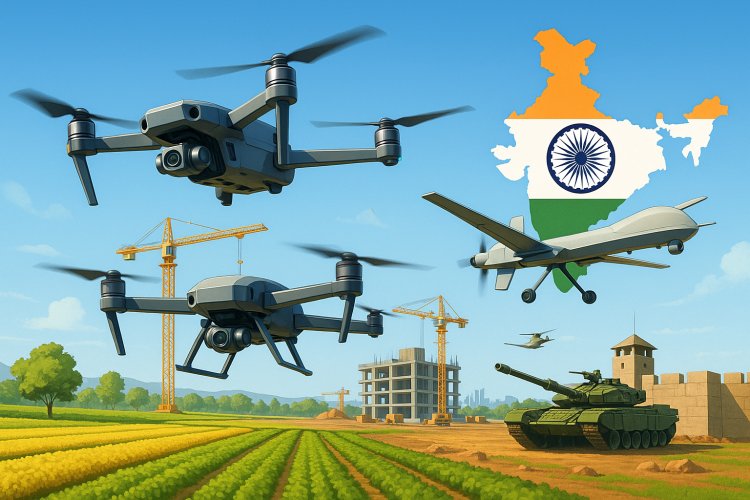
How will PLI schemes and government policies accelerate
India's drone industry growth
Production-Linked Incentive (PLI) schemes and progressive government policies are serving as primary accelerators for India's drone industry growth, driving self-reliance, manufacturing scale, and technological innovation.
Key Ways PLI Schemes and Policies Accelerate Growth:
-
Direct Financial Incentives: The PLI scheme provides financial rewards for manufacturers and components makers that achieve specified value addition and sales thresholds. For example, ₹120 crore was initially allocated over three years, and recent increases—with funds up to ₹2,000 crore proposed for FY 2025–28—directly support both large-scale manufacturers and startups. These incentives reduce upfront risk and support capital investment in factories, R&D, and talent acquisition.
-
Stimulating Indigenous Manufacturing: By linking incentives to the proportion of local value addition (minimum 40% for drones/components), the PLI scheme pushes manufacturers to domestically source parts, decrease import dependence, and build an indigenous supply chain. Government import restrictions on foreign drones further boost demand for local products.
-
Expanding Eligible Activities: Recent policy iterations are broadening the scope of incentives to cover services like drone leasing, indigenous software development, counter-drone solutions, and associated R&D—expanding the value chain beyond just hardware.
-
Regulatory Simplification: Policies such as the liberalized Drone Rules 2021 have streamlined licensing, enabled a single-window online portal (UDAN), and opened 90% of Indian airspace as “green zones” for drones, reducing operational barriers and accelerating commercial adoption.
-
Startups and MSME Focus: Growth in sector turnover has been significantly driven by MSMEs and startups, who benefit from both the financial incentives and simplified regulations. Turnover in the drone sector increased sevenfold under the PLI scheme after its implementation.
-
Sectoral Integration and Demand Creation: Government procurement policies are actively inducting drones into defense, agriculture, infrastructure, healthcare, and logistics, providing an assured domestic market and demand pipeline.
-
R&D and Technology Advancement: Budget outlays also target R&D funding, public-private collaborations, and university research partnerships, accelerating innovation in drone sub-systems, AI, and autonomous technologies. The National Geospatial Mission and special government funding for deep-tech R&D are notable examples.
-
Export and Global Leadership: Simplifying export regulations and actively promoting Indian drone tech internationally positions India as a global contender, not just a domestic hub.
Evidence of Accelerated Growth:
-
The combined annual sales turnover of PLI beneficiaries jumped from INR 880 million to INR 3.19 billion in just one year.
-
Industry turnover has increased sevenfold under the PLI scheme.
-
The broader policy push aims to create a $15–30 billion industry by 2030, with a targeted 35% CAGR between 2025 and 2030.
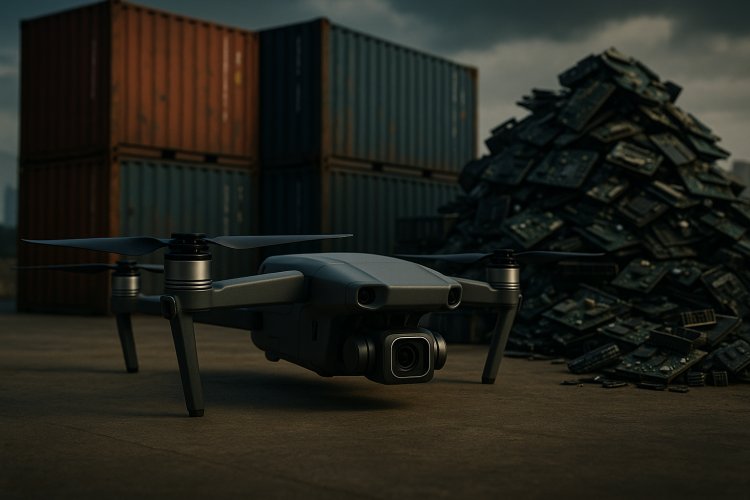
What risks could hinder India's rise as a leading drone manufacturing and export nation
Several significant risks could hinder India's rise as a leading drone manufacturing and export nation over the next decade:
-
Dependence on Imported Components: More than 60% of critical drone parts—such as sensors, flight controllers, and batteries—are still sourced from abroad, particularly China. This reliance exposes the sector to geopolitical disruptions, supply chain breakdowns, sanctions, and national security vulnerabilities. Even with ongoing localization, key technologies like LiDAR sensors or high-performance microchips remain challenging to manufacture domestically.
-
Persistent Regulatory Uncertainty: Although the Drone Rules 2021 improved the regulatory landscape, India still faces delays and complexity in approvals, certifications, and lack of clear norms for advanced operations such as Beyond Visual Line of Sight (BVLOS) flights. These gaps slow innovation and deter international investors who need predictable frameworks to scale manufacturing and exports.
-
Cybersecurity Risks: Many Indian drones continue to rely on commercial off-the-shelf components and foreign software, making them susceptible to hacking, GPS spoofing, and data breaches. This is a critical threat in defense and industrial applications. Insufficient investment in indigenous cybersecurity R&D further magnifies this vulnerability.
-
Shortage of Skilled Workforce: The industry is constrained by a major shortage of specialized talent—drone engineers, pilots, AI experts—which slows innovation and hinders scaling. While training initiatives are in place, skill gaps are likely to persist for several years without major educational and skilling investment.
-
High R&D Costs and Funding Gaps: Advanced drone development requires significant capital, but Indian deep-tech startups often face funding shortages compared to those in the US, China, or Israel. Venture capital tends to favor consumer tech or software, leaving hardware and R&D-heavy projects underfunded.
-
Raw Material and Rare-Earth Dependencies: India's drone industry is indirectly vulnerable to rare-earth supply fluctuations. If exporting countries (notably China) restrict rare-earth or key electronics exports, India could face severe cost escalations or supply disruptions.
-
Low Rural and MSME Adoption: Despite growth in sectors like defense and urban logistics, drone adoption in agriculture and rural industries is slow, mainly due to high costs, limited awareness, and lack of access to government subsidies or training.
-
Weaknesses in Counter-Drone Technology: As drone misuse and security threats rise, India's domestic counter-drone technology remains underdeveloped relative to global leaders, making both domestic and exported products potentially less attractive in competitive tendering.
-
Infrastructure and Logistics Gaps: Inadequate manufacturing infrastructure, logistics bottlenecks, and limited facilities for large-scale testing and export certification can constrain output and reliability.
-
Global Competition and Market Access Barriers: Established players like DJI (China) and leading US or Israeli firms have technological and brand leadership in key export markets. Without unique advantages or strong government-backed diplomacy, Indian manufacturers could struggle to capture significant global share beyond domestic procurement.
Conclusion
Drones are not a passing trend in India—they are set to alter the trajectory of defense, agriculture, logistics, and economic growth itself. The country’s regulatory pivot, government incentives, rising startup culture, and focus on indigenous manufacturing are setting the stage for India not just to be a major market, but a true drone superpower.
PLI schemes and reformist government policies are creating a supportive ecosystem that reduces risk, cuts bureaucracy, unleashes capital for innovation, and pushes for self-reliance—paving the way for India to become a global drone hub and unlocking massive growth across technology, manufacturing, and service domains.
Successful mitigation of these risks will require sustained investment in R&D, robust and consistent regulatory reforms, aggressive skilling programs, and strategic efforts to build secure, indigenous supply chains—especially for critical hardware and software. Without these, India could fall short of its ambitious drone manufacturing and export targets despite strong market growth potential.
The global and geopolitical landscape, particularly the lessons learned from recent conflicts, have unequivocally highlighted that drones are no longer optional – they are inevitable. India's proactive approach, combining simplified regulations, generous incentives, a robust defense procurement strategy, and a blossoming start-up ecosystem, signals a clear intent to not just participate but to lead in the global drone arena.
For stock market investors, the message is clear: the drone industry is on the cusp of a significant lift-off. Identifying the early movers and those strategically positioned – be it IdeaForge, Zen Tech, or NeoSky – could very well mean holding tomorrow's most strategic multi-baggers, as India truly becomes the "new engine for economic transformation" propelled by propellers and profits. The sky is indeed the limit for India's drone dream.

 Editor
Editor 































